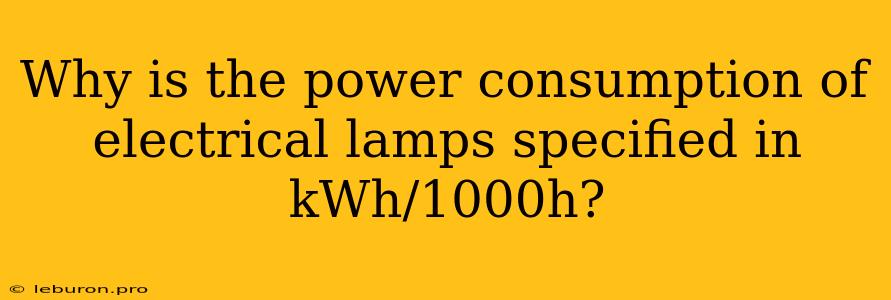The power consumption of electrical lamps is often specified in kWh/1000h, a unit that might seem a bit confusing at first glance. This seemingly odd unit actually provides a clear and practical way to understand how much energy a lamp uses over a specific period. This article will delve into the reasons behind this specific unit and how it helps us make informed choices about our lighting needs.
Understanding the Unit: kWh/1000h
kWh/1000h stands for "kilowatt-hours per 1000 hours." This unit represents the energy consumption of a lamp over a period of 1000 hours. To understand this better, let's break down its components:
- Kilowatt-hour (kWh): A kilowatt-hour is a unit of energy. It represents the amount of energy used by a device with a power rating of 1 kilowatt running for one hour.
- 1000 hours: This refers to the time period over which the energy consumption is measured.
In essence, kWh/1000h tells us how much energy a lamp will consume in 1000 hours of operation. For example, a lamp with a power consumption of 10 kWh/1000h will use 10 kilowatt-hours of energy if it runs continuously for 1000 hours.
Why Use kWh/1000h for Lamps?
The use of kWh/1000h for specifying the power consumption of electrical lamps is driven by several practical reasons:
1. Ease of Comparison:
By standardizing the time period to 1000 hours, it becomes easier to compare the energy efficiency of different lamps. If two lamps have different power consumptions in kWh/1000h, we can directly compare them to see which one uses less energy over a long period.
2. Relevance to Lamp Lifespan:
The lifespan of most incandescent lamps is around 1000 hours. Therefore, specifying energy consumption in kWh/1000h provides a practical measure of how much energy the lamp uses over its entire lifespan. This allows consumers to understand the total energy cost associated with using the lamp.
3. Consistency with Other Appliances:
Many household appliances, such as refrigerators and washing machines, also have their energy consumption specified in kWh/1000h. This consistency helps consumers compare the energy usage of different appliances across various categories.
Practical Applications of kWh/1000h
The use of kWh/1000h has several practical applications for both consumers and manufacturers:
- Energy Savings: By understanding the energy consumption of different lamps, consumers can make informed choices about which lamps to purchase. Opting for lamps with lower kWh/1000h values can significantly reduce energy bills and contribute to environmental sustainability.
- Cost Comparison: Comparing the cost of various lamps based on their kWh/1000h values can help consumers find the most cost-effective options. It is important to consider both the initial purchase price of the lamp and the ongoing energy costs associated with its operation.
- Product Labeling: The kWh/1000h value is often included on lamp packaging, allowing consumers to make informed choices at the point of purchase. This transparency promotes a more energy-conscious approach to lighting.
- Energy Efficiency Regulations: Governments often set energy efficiency standards for lamps, often expressed in terms of kWh/1000h. This encourages manufacturers to develop more energy-efficient lamps, reducing overall energy consumption and carbon emissions.
Conclusion
The use of kWh/1000h for specifying the power consumption of electrical lamps provides a clear, standardized, and practical approach to understanding energy usage. This unit facilitates comparisons between lamps, allows for accurate cost estimation, and supports informed purchasing decisions. By understanding the importance of this unit, we can make more energy-efficient choices for our lighting needs, contributing to both cost savings and environmental sustainability.
